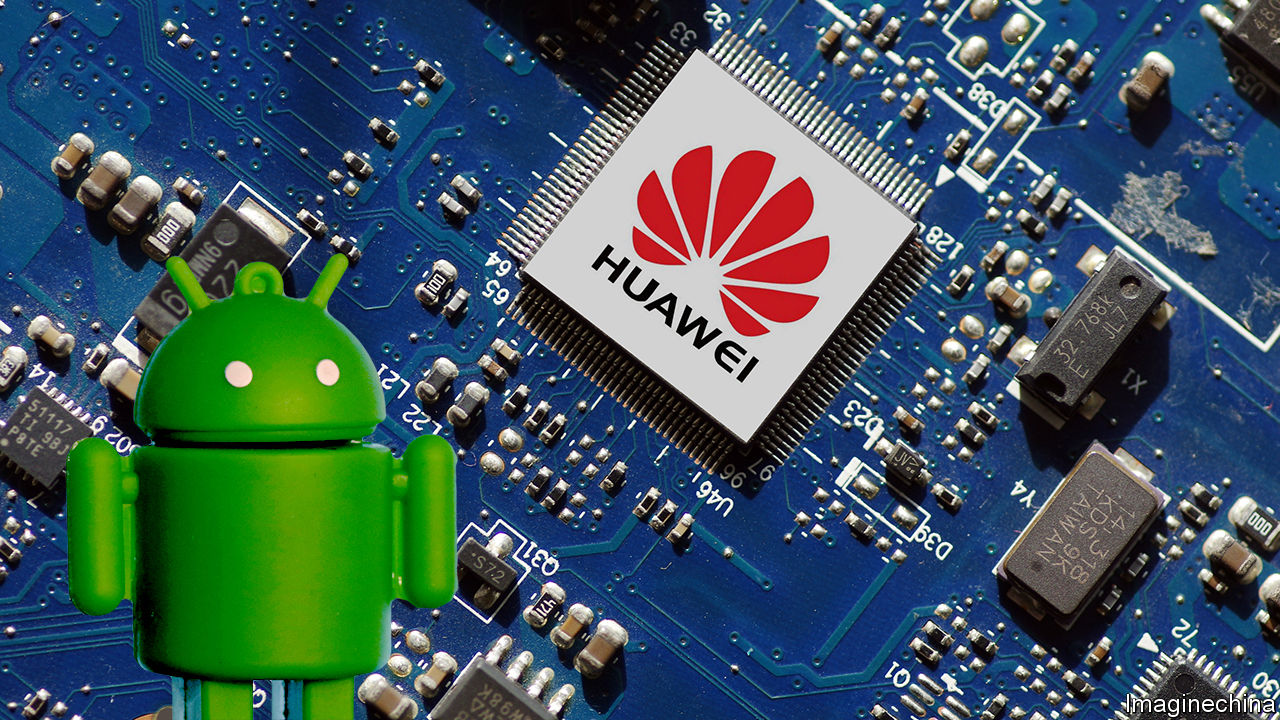
ON MAY 20TH it became clear that some of the world’s most prominent technology companies—Google, Intel and Qualcomm—had stopped selling software, hardware and licences for intellectual property to Huawei, a Chinese manufacturer of phones and networking gear. This followed an announcement by the American government on May 15th that it was banning the export of American technology to Huawei unless companies got a special licence from the Department of Commerce.
Huawei, which sources a sixth of all its components from American companies, appears vulnerable. It has stockpiled enough components to keep its business running for several months. But reconfiguring its supply chain so that it is no longer reliant on American firms, which would be the only way to truly insulate itself from the trade wars, will be hard.
Google has stopped supplying Huawei with the proprietary components of Android, the search firm’s mobile operating system. That loss will have no effect on Huawei’s biggest market, mainland China, where it only uses the free, open-source components of Android. But outside China, where the firm bundles Google’s own services like Gmail and search with the tens of millions of phones it sells every year, the loss of Google’s software is crippling (and is a boon for Samsung, the South Korean market leader). Huawei is working on its own alternative, codenamed HongMeng OS according to state media, but is unlikely to be able to deploy it without significant disruption.
Huawei’s hardware is threatened, too. Intel, Qualcomm and a host of other companies have stopped supplying the parts and designs that Huawei needs to build its phones and network gear. Huawei’s sales grew by 20% in 2018 to $107bn. If the supply tap is not turned back on, 2019 will be rather less rosy.
Farther removed from American jurisdiction, Huawei’s Asian suppliers have been more circumspect. TSMC, the Taiwanese company which makes the semiconductors on which Huawei’s entire business (and that of most other technology companies) depends, is still supplying the firm, but says that it is examining its export-control systems to make sure that it is in compliance with American law. Other Taiwanese companies are following its lead.
Huawei’s Asian suppliers must obey American law on export control, in theory at least, because it prohibits not just the direct sale of American technology by American firms, but also its transmission through non-American companies like TSMC. In reality, America has few levers to force companies like TSMC to comply with its laws. Losing TSMC as a supplier would be the final blow for Huawei. Currently, that is unlikely, but if conflict escalates TSMC could become the next battleground.
Huawei says it has been preparing for an American assault on its supply chains for years. In April, Peter Zhou, a company executive, suggested that the firm had anticipated the rising tension between China and America and prepared accordingly. The firm says it has been remaking its supply chains and so will not crack under pressure as its domestic competitor, ZTE, did last year when faced with a similar ban (one ultimately lifted by President Donald Trump in response to a personal plea from the Chinese president, Xi Jinping).
But the actual state of Huawei’s preparations may be better gauged by comments made by Ren Zhengfei, the boss, on May 18th. He claimed that the company would be “fine” without its American suppliers, yet conceded that he expected revenues to grow 20% more slowly as a result of the ban. If America retains the ban as Huawei’s stockpiles dwindled, the company—and indeed China’s internet ecosystem—would be more seriously damaged. More probably, America will use its ability to withhold components from Huawei as a bargaining chip in a future trade deal with China.
Further such action could also harm America and its allies. Beijing would probably retaliate, perhaps disrupting the supply chains of American companies within China. And although American export law is a powerful weapon in this trade war, its impact will diminish with time. Every time America lashes out at a Chinese company it hastens Chinese efforts to find suppliers elsewhere. Huawei’s semiconductor division, HiSilicon, has been designing its own versions of the chips it buys from American companies. The firm’s HongMeng OS is waiting in the wings. Next time America wants to attack the supply chain, it may find that there are fewer convenient targets.








